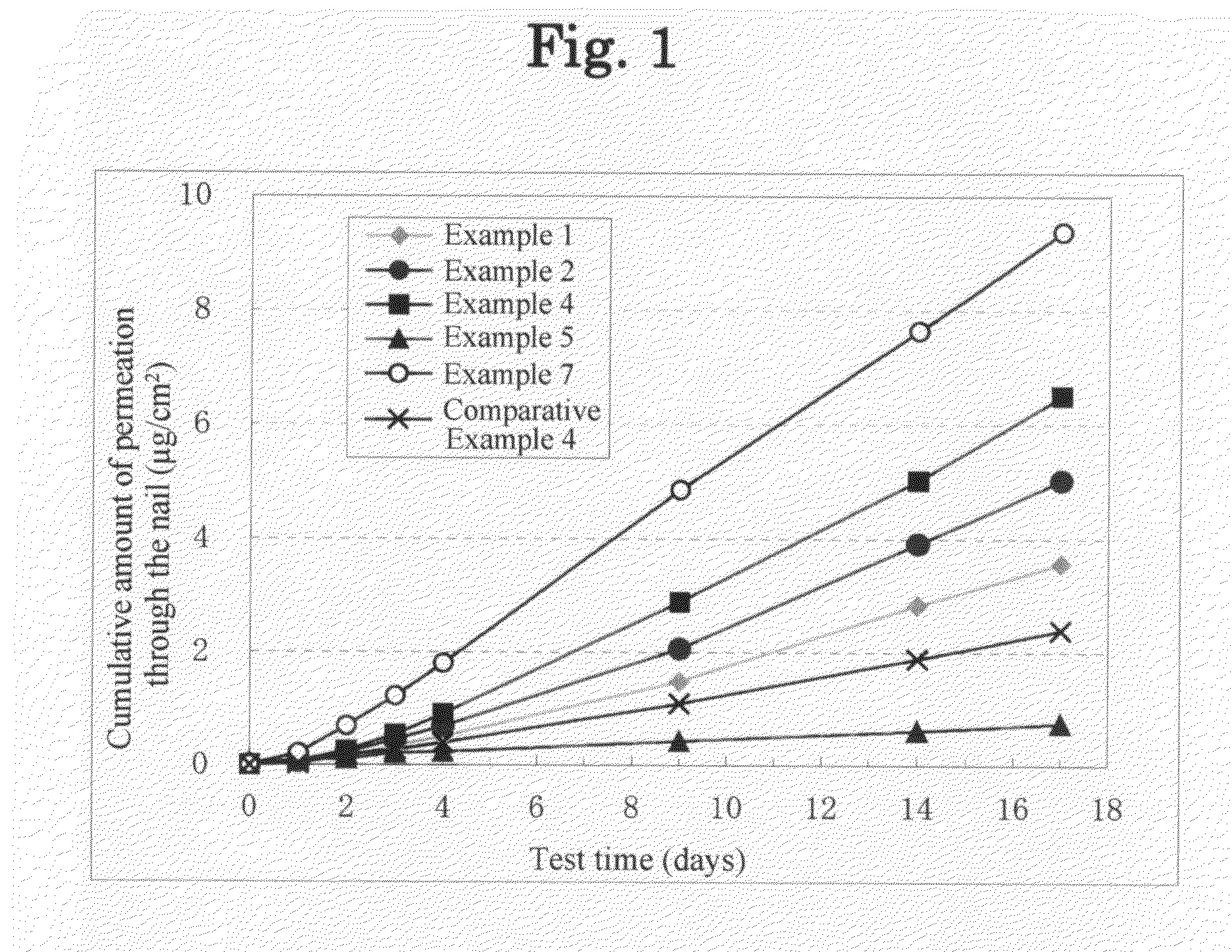Antimycotic Patch
a technology of mycotic patch and antimycotic gel, which is applied in the field of transdermal patch, can solve the problems of insufficient retention of the drug at the affected area for a sufficient amount of time, patient substantial failure to administer the drug several times per day and other problems, and achieve the effect of sufficient
- Summary
- Abstract
- Description
- Claims
- Application Information
AI Technical Summary
Benefits of technology
Problems solved by technology
Method used
Image
Examples
example 1
[0068]A patch was obtained according to the composition and production process described below.
1. Terbinafine*120.0%2. Acrylic-based pressure-sensitive adhesive*279.7%(solid content)3. Polyisocyanate*30.3%*1Purchased from Kaneda Corp.*2Obtained by ordinary solution polymerization of 96% 2-ethylhexyl acrylate and 4% acrylic acid using 0.5 parts of polymerization initiator in the form of lauryl peroxide in ethyl acetate at a concentration of 33%. Subsequent values for the pressure-sensitive adhesive indicate the solid content thereof.*3Coronate HL (Nippon Polyurethane Industry Co.)
[0069](Production Process)
[0070]After weighing out each of the above ingredients, the total solid content was adjusted to 25% in ethyl acetate and stirred to uniformity. The solution was coated onto a 75 μm-thick PET (polyethylene terephthalate) film and subjected to silicone treatment on one side thereof (Filmbyna 75E-0010 No. 23, Fujimori Kogyo Co., Ltd.) so that the thickness of the pressure-sensitive adh...
examples 2 to 6
[0072]Patches were obtained using the compositions shown in Table 1 and the same production process as Example 1, and making the content of terbinafine 30.0%, 32.0%, 35.0%, 5% or 1%.
TABLE 1Exam-Exam-Exam-Exam-Exam-ple 2ple 3ple 4ple 5ple 6Terbinafine *130.0%32.0%35.0% 5% 1%Acrylic-based pressure69.6%67.6%64.5%94.7%98.7%sensitive adhesive *2Polyisocyanate *30.4%0.4%0.5% 0.3% 0.3%*1 Same as that used in Example 1*2 Same as that used in Example 1*3 Coronate HL (Nippon Polyurethane Industry Co., Ltd.)
example 7
[0073]A patch was obtained using the following composition and production process while making the terbinafine content 10.0% and using a silicone-based pressure-sensitive adhesive for the base.
1. Terbinafine*110.0%2. Silicone-based pressure-sensitive adhesive*90.0%*1Same as that used in Example 1*4BIO-PSA4501 (Dow Corning Corp.)
[0074]A mixture of polydimethylsiloxane and MQ resin (branched polysiloxane having M unit ((CH3)3SiO1 / 2) and Q unit (SiO2)) at the a composite ratio of 60:40 in heptane at a concentration of 63% was polymerized by ordinary solution polymerization. Subsequent values for the pressure-sensitive adhesive indicate the solid content thereof.
[0075](Production Process)
[0076]Each of the above ingredients was weighed and stirred to uniformity. The solution was coated onto a 75 μm-thick PET (polyethylene terephthalate) film and subjected to silicone treatment on one side thereof (Filmbyna 161-8066 FN-75, Fujimori Kogyo Co., Ltd.) so that the thickness of the pressure-se...
PUM
| Property | Measurement | Unit |
|---|---|---|
| partition coefficient | aaaaa | aaaaa |
| /water partition coefficient | aaaaa | aaaaa |
| water partition coefficient | aaaaa | aaaaa |
Abstract
Description
Claims
Application Information
 Login to View More
Login to View More - R&D
- Intellectual Property
- Life Sciences
- Materials
- Tech Scout
- Unparalleled Data Quality
- Higher Quality Content
- 60% Fewer Hallucinations
Browse by: Latest US Patents, China's latest patents, Technical Efficacy Thesaurus, Application Domain, Technology Topic, Popular Technical Reports.
© 2025 PatSnap. All rights reserved.Legal|Privacy policy|Modern Slavery Act Transparency Statement|Sitemap|About US| Contact US: help@patsnap.com


